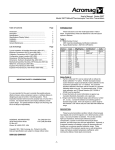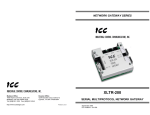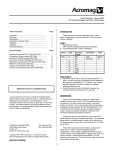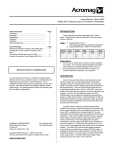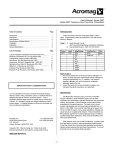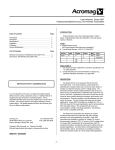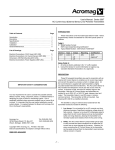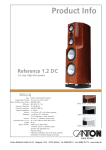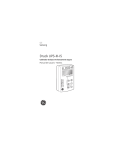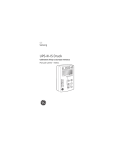Download - 1 - User`s Manual: Series 270I Model 270I Process Current Loop
Transcript
User's Manual: Series 270I Model 270I Process Current Loop-Powered Isolator INTRODUCTION: Table of Contents Page Introduction.......................................................................... Description........................................................................... Specifications ..................................................................... Installation ........................................................................... Calibration ........................................................................... General Maintenance .......................................................... List of Drawings These instructions cover the model types listed in Table 1 below. Supplementary sheets are attached for units with special options or features. 1 1 2 3 4 4 Table 1: A. Model Number Format: 1 270I-Input-Mounting-Certification 1 B. Typical Model Number: 270I-20MA-DIN-NCR Page Electrical Connections (4501-106)......................................... Calibration Connection & Simplified Schematic (4501-105).. Dimensions: DIN Rail Mounting (4501-107)........................... Dimensions: Surface & Snaptrack Mtg. (4501-108).............. NEMA 4 & 12 Enclosures (4501-109)................................... Explosion Proof Enclosure (4501-110).................................. Series 270I 6 7 8 9 10 11 -Input 20MA -Mounting -DIN -SM -ST -N4 -N12 -XP -Certification 2 -NCR Notes (Table 1): 1. All units are factory calibrated for 4 to 20mA (no "-C" needed). 2. Consult the factory for current information on agency (e.g. Canadian Standards Association, etc.) approvals. DESCRIPTION: This two-wire, loop-powered isolator accepts a 4 to 20mA input signal and provides an isolated 4 to 20mA output signal. It is designed to break the galvanic path between a transmitted signal source and the receiving device. The isolator is highly effective in eliminating unreliable or inaccurate signal transfer by providing total current-to-current signal isolation. The isolator is RFI-protected, operates over a wide temperature range, and features excellent temperature coefficients, which minimize the effects from harsh plant environments. See Drawing 4501-105 for a simplified schematic. IMPORTANT SAFETY CONSIDERATIONS It is very important for the user to consider the possible adverse effects of power, wiring, component, sensor, or software failures in designing any type of control or monitoring system. This is especially important where economic property loss or human life is involved. It is important that the user employ satisfactory overall system design. It is agreed between the Buyer and Acromag, that this is the Buyer's responsibility. Key 270I Features: √ √ √ √ Acromag, Inc. 30765 South Wixom Road P.O. Box 437 Wixom, Michigan 48393-7037, USA Transformer Isolation Signal Loop Powered 0-600Ω Load Range High Accuracy √ √ No Load Trimming Required Wide Temperature Range √ √ Input Current Sense Resistor Versatile Mounting Configuration Power to operate the unit is derived from the input signal current--no external power supply is required. When a signal isolation device is installed, it is important to consider the voltage drop or additional line resistance that will be placed in the system. Any additional load tends to reduce the line or drive potential and may exceed the source rating. The effect of voltage drop within the system must be calculated to ensure that drive capability is not exceeded. Total maximum voltage drop in the input current loop is the sum of the isolator's fixed voltage drop, plus the voltage required to drive the output load. The output load resistance range is from 0 to 600 ohms. Tel: (248) 624-1541 FAX: (248) 624-9234 Copyright 1991, 1994, Acromag, Inc. Printed in the USA. Data and specifications are subject to change without notice. 8500-288-B94C002 -1- Series 270I User's Manual Isolator Process Current Loop-Powered ____________________________________________________________________________________ Equation (Refer to Figure 1): Input Voltage Drop = 5.4V DC + (0.0216A x R-load) Placing a resistor across the output terminals will provide a voltage output proportional to the loop current, such as; 1 to 5V DC (4 to 20mA) for a 250 ohm load.. A unique feature of this isolator is that once it is calibrated, it does not have to be recalibrated for different loads (up to 600 ohms). That is, calibration is independant of the load. The isolator is calibrated at the factory with a 250 ohm load and the need for a load trim adjustment is not required for other load values. Example (R-load = 250 ohms): Input Voltage Drop = 5.4V DC + (0.0216A x 250Ω) = 10.8V DC. Current Sense Resistor: A built-in 10 ohm (±0.1%) resistor is available to monitor the input current to the isolator. The wiring to the isolator's input terminals determines if this resistor is included in the current loop or not. The use of this resistor provides a test signal of 40mV to 200mV, representing 4 to 20mA. See Drawing 4501-106 for wiring details. Note that the use of this resistor will increase the Input Voltage Drop by 200mV (10 ohms x 20mA). To facilitate field indication of the current going into the isolator, the user has the option to wire the input to include a built-in 10Ω resistor (±0.1%, ±25ppm/oC) in the current loop. This provides a test signal of 40 to 200mV that is directly proportional to the 4 to 20mA input signal. The only penalty is the increased fixed voltage drop that results (200mV). Again, the use of this resistor is optional. Input V-Drop = 5.4VDC +(0.0216A xR-load), no sense resistor. Input V-Drop = 5.6VDC +(0.0216A xR-load), w/ sense resistor. These field mounted loop-powered isolators are designed to utilize one of a number of customer-specified mounting configurations. The isolator is available for DIN-rail mounting, surface mounting, 3-inch SNAPTRACKTM plastic rail mounting, or in various housings. These housings include NEMA 4, 12, and explosion-proof enclosures. The model number of the unit specifies the mounting/enclosure type (refer to Table 1). Isolation: The input and output circuits are isolated from each other for common-mode voltages up to 250V AC, or 354V DC off ground, on a continuous basis (will withstand 1500V AC dielectric strength test for one minute without breakdown). This complies with the test requirements outlined in ANSI/ISAS82.01-1988 for the voltage rating specified. Input wiring is inserted in the top of the unit, while output wiring is inserted in the bottom, or field side of the unit. Screws to secure the wiring are located on the front panel. Connectors are screwclamp type and accept wire size up to #14 AWG. Output: 4-20mA DC output into 0 to 600 ohms. A. For R-load from 50 to 600 ohms: Connect R-load between the Output(+) and Output(-) terminals. B. For R-load from 0 to 50 ohms: Connect R-load between the Output(S) and Output(-) terminals. For optimum performance at low values of R-load, the isolator has a builtin pad resistor of 50 ohms. SPECIFICATIONS: Function: This loop powered isolator accepts a 4 to 20mA input signal, provides input-to-output circuit isolation, and produces a 4 to 20mA output for loads from 0 to 600 ohms. Zero and span trim adjustments utilize 22-turn potentiometers accessible from the front of the unit. The isolator has various mounting and enclosure options available. 1. Input Voltage Drop (with the input sense resistor not used): Input Voltage Drop = 5.4VDC +[0.0216A x (R-load + 50Ω)] 2. Input Voltage Drop (with the input sense resistor used): Input Voltage Drop = 5.6VDC +[0.0216A x (R-load + 50Ω)] MODEL/SERIES: 270I- (Color coded with a Red label) Reference Test Conditions: Input/Output current: 4 to 20mA; output load 250 ohms; 77oF (25oC) ambient. INPUT:- 20MA: 4 to 20mA input. Power to operate the loopisolator is derived from the input signal loop. Input current should be limited to less than 50mA to prevent damage to the isolator. In the event of an open output circuit, the input loop voltage drop is limited to 20V, nominal. Isolator has reverse polarity protection. Accuracy: Better than ±0.1% of output span. This error includes the combined effects of isolator repeatability, hysteresis, terminal point linearity, and adjustment resolution. Ambient Temperature Range: -13oF to 185oF (-25oC to 85oC). Input Voltage Drop: The input voltage drop is a function of the input current as follows: Vinput 18.36V Rinput 850Ω 16.20V 750Ω 14.04V 650Ω 11.88V 550Ω 9.72V 450Ω 7.56V 350Ω 5.40V 250Ω 0 Ambient Temperature Effect: Less than ±0.006% of output span per oF (± 0.01% per oC) over the ambient temperature range for reference test conditions (Specification includes the combined effects of zero and span over temperature). Load Resistance Effect: Less than ± 0.1% of output span as load resistance is changed over entire range. Allows use of isolator, within resistance load range, without the need to recalibrate the isolator for a particular load. Output Ripple: Less than ±0.1% of the maximum output span. Bandwidth: -3 dB at 3 Hz, typical. 100 200 300 400 500 600 OUTPUT LOAD RESISTANCE (Ω) Response Time: For a step input, the output reaches 98% of output span within 80mS, typical. )LJXUH ,QSXW %XUGHQ YV 2XWSXW /RDG P$ /RRS &XUUHQW -2- Series 270I User's Manual Isolator Process Current Loop-Powered ____________________________________________________________________________________ Explosion Proof, Water-Tight Enclosures: Option type listed below. Refer to Drawing 4501-110 (no display window) for outline and clearance dimensions. Enclosure Materials: Body and cover - Copper-free aluminum (less than 0.4%), Gasket - Neoprene. Finish: Corro-free epoxy powder coat, color gray. Hub size: 0.75 inch (Quantity 2). Housing meets Class I - Groups B, C, & D, Class II - Groups E, F, & G, Class III, and NEMA 4 (water-tight) requirements. Isolator is mounted within enclosure at the factory. Noise Rejection: Common Mode: Better than 110dB at 60 Hz, typical. RFI Resistance: Less than ± 0.5% of output span with RFI field strengths of up to 10V/meter at frequencies of 27MHz, 151MHz, and 467MHz. EMI Resistance: Less than ±0.25% of output span effect with switching solenoids or commutator motors. Surge Withstand Capability (SWC): Input/Output terminations rated per ANSI/IEEE C37.90-1978. Unit is tested to a standardized test waveform that is representative of surges (high frequency transient electrical interference), observed in actual installations. -XP: Explosion Proof, Water-Tight Enclosure (No Window). Shipping weight: 5 pounds (2.3Kg) packed. CERTIFICATION: Consult the factory for current information on the availability of agency (e.g. Canadian Standards Association, Factory Mutual, etc.) approvals. Construction (Basic Isolator): Circuit Board: Military grade FR-4 epoxy glass circuit board. Circuit Board Coating: Fungus resistant acrylic conformal coat. Terminals: Compression type, wire size 14 AWG maximum. Mounting Position: Position insensitive. Case: Self-extinguishing NYLON Type 6.6 polyamide black thermo-plastic UL94- V-2, General Purpose, NEMA Type 1 enclosure -NCR: No Certification Required. INSTALLATION: The isolator is packaged in a general purpose plastic housing and optionally mounted within a variety of protective enclosures. The isolator should be located in an area that is protected from dust, moisture, and corrosive atmospheres. The enclosure type determines the protection afforded in a particular environment and location, make sure that this is not compromised. Maximum operating ambient temperatures should be within -13 oF to 185oF (-25 oC to 85oC) for satisfactory performance. If unit is factory calibrated, it is ready for installation. Connect as shown in Connection Drawing 4501-106. To verify calibration, refer to the "CALIBRATION" section. MOUNTING: A wide variety of mounting options and enclosures are available to meet the needs of the installation. The available models are listed below. The isolator is shipped as a complete assembly. -DIN: General Purpose Housing, DIN Rail-Mount - "G" & "T" rails. "G" Rail (32mm), Type EN50035; "T" Rail (35mm), Type EN50022. Refer to Drawing 4501-107 for outline and clearance dimensions. Shipping Weight: 1 pound (0.45 Kg) packed. -SM: General Purpose Housing, Surface-Mount. Refer to Drawing 4501-108 for outline and clearance dimensions. Shipping Weight: 1 pound (0.45 Kg) packed. -ST: General Purpose Housing, SNAPTRACK™. Refer to Drawing 4501-108 for outline and clearance dimensions. Shipping Weight: 1 pound (0.45 Kg) packed. SNAPTRACK™ is a registered trademark of Reed Devices, Inc. Mounting: Mount isolator assembly - refer to appropriate outline drawing for mounting and clearance dimensions. Determine which configuration is utilized and consult the proper mounting instructions listed below. 1. DIN Rail Mounting: Use suitable fastening hardware to secure the DIN rail to the designated mounting surface. An isolator ordered with the DIN Rail mounting option (-DIN) can be mounted to either the "T" or "G" Rail. Installation of the isolator to the rail depends on the type of DIN rail used (see Drawing 4501-107). Units can be mounted side-byside on 1.0-inch centers, if required. 2. Surface Mounting: Secure the isolator to the designated mounting surface using two 6-32 screws. Note that the mounting bracket has screw slots to facilitate mounting. Units can be mounted side-by-side on 1.0-inch centers, if required. NEMA 4 and 12 Enclosures: Option types listed below. Refer to Drawing 4501-109 for outline and clearance dimensions. Isolator is mounted within enclosure at the factory. These enclosures may accommodate a second Series 270I isolator with the Surface-Mount option (-SM option, ordered separately). Conduit mounting holes and fittings are customer supplied. -N4: Water-Tight Enclosure, NEMA 4. Enclosure material and finish: 0.075 and 0.060 inch thick steel with gray hammertone enamel finish inside and out. Shipping weight: 6 pounds (2.7 Kg) packed. -N12: Oil-Tight Enclosure, NEMA 12. Enclosure material and finish: 0.075 and 0.060 inch thick steel with gray hammertone enamel finish inside and out. Shipping weight: 6 pounds (2.7 Kg) packed. -3- Series 270I User's Manual Isolator Process Current Loop-Powered ____________________________________________________________________________________ 3. SNAPTRACK™ Mounting: Secure the SNAPTRACK™ mounting channel to the designated mounting surface using suitable fastening hardware. To install the unit in the mounting channel, place the bottom end of the mounting bracket between the rails and press the top (notched end) firmly until the bracket "snaps" into place. To remove the isolator, insert a screwdriver into the upper arm of the connector, twist to release the unit from the track and tip the unit out. Units can be mounted side-by-side on 1.0-inch centers, if required. 3. Grounding: The isolator in the General Purpose Housing is plastic and does not require an earth ground connection. If the isolator is mounted in a metal housing, a ground wire connection is required. Connect the ground terminal (Green Screw) to a suitable earth ground using suitable wire per applicable codes. CALIBRATION: All units are calibrated and checked for proper performance at the factory before they are shipped. The calibration example below is provided for reference. 4. NEMA 4 & 12 Enclosure Mounting: Secure the enclosure assembly to the designated mounting surface using appropriate hardware. The isolator is secured within this enclosure using two screws. Note: It is recommended that the isolator be removed from the enclosure during the process of drilling holes, installing fittings, and mounting the enclosure. Isolator - Adjustment Procedure: Connect the isolator as shown in Connection Drawing 4501-106. The input current source must be adjustable over the entire input range of the unit and settable to an accuracy of 0.05% or better, for proper results. Note: It is recommended that the isolator be removed from the enclosure during the process of mounting the enclosure. To remove the unit from the enclosure, remove two screws securing it to the bottom of the enclosure. After the enclosure is installed, install the isolator into the enclosure. Position the unit at an angle that permits all wiring to be routed unobstructed through both ports. If the isolator has the display option, make sure the orientation of the display allows for easy reading once installed. Secure the isolator assembly to the enclosure using two screws. The Zero and Span adjustments are accessible on the front panel of the isolator (see Drawing 4501-106 for their location). The screwdriver blade, used to adjust the potentiometers, should not be more than 0.1 inch (2.54mm) wide. Isolator - Calibration Example: MODEL : 270I-20MA-DIN-NCR Output : 4-20mA Input : 4-20mA Electrical Connections: 1. Set the input source to 4.000mA. Adjust the Zero (Z) pot until the output reads 4.000mA DC. 2. Set the input source to 20.000mA. Adjust the Span (S) pot until the output reads 20.000mA DC. 3. Repeat steps 1 and 2 until the readings converge. The instrument is now calibrated. Several mid-point values should also be checked to verify proper operation of the isolator. The wire size used to connect the unit to the control system is not critical. All terminal strips can accommodate wire from 14-26 AWG. Strip back wire insulation 1/4-inch on each lead before installing into the terminal block. Input wiring may be shielded or unshielded twisted pair. Output wires should be twisted pair. Since common mode voltages can exist on signal wiring, adequate wire insulation should be used and proper wiring practices followed. It is recommended that input wiring be separated from output signal wiring for safety, as well as for low noise pickup. GENERAL MAINTENANCE: 1. Input: Connect input per connection diagram. Observe proper polarity. Note: Input/Output circuits are isolated from each other allowing the output circuit to operate with common mode voltages up to 250V AC or 354V DC off ground on a continuous basis. The power to operate this loop-isolator is derived from the input signal. For a 250 ohm load, the input voltage drop with 20mA output is 10.8VDC (5.4VDC + (0.0216 x R-load)). Determine the input voltage requirements for your load. Make sure your input source is capable of handling the required voltage drop. The isolator contains solid-state components and requires no maintenance, except for periodic cleaning and calibration verification. When a failure is suspected, a convenient method for identifying a faulty isolator is to exchange it with a known good unit. It is highly recommended that a non-functioning isolator be returned to Acromag for repair, since Acromag used tested and burned-in parts, and in some cases, parts that have been selected for characteristics beyond that specified by the manufacturer. Further, Acromag has automated test equipment that thoroughly checks the performance of each isolator. 2. Output: Make output circuit connections to the loopisolator as shown in the Connection Drawing 4501-106. The 4-20mA DC output signal can be used with a resistor load from 0 to 600 ohms. For resistance loads from 50 to 600 ohms, connect R-load between the Output(+) and Output(-) terminals. For resistance loads from 0 to 50 ohms, connect R-load between the Output(S) and Output(-) terminals. The Output(S) terminal has a built-in padding resistor of 50 ohms. -4-










